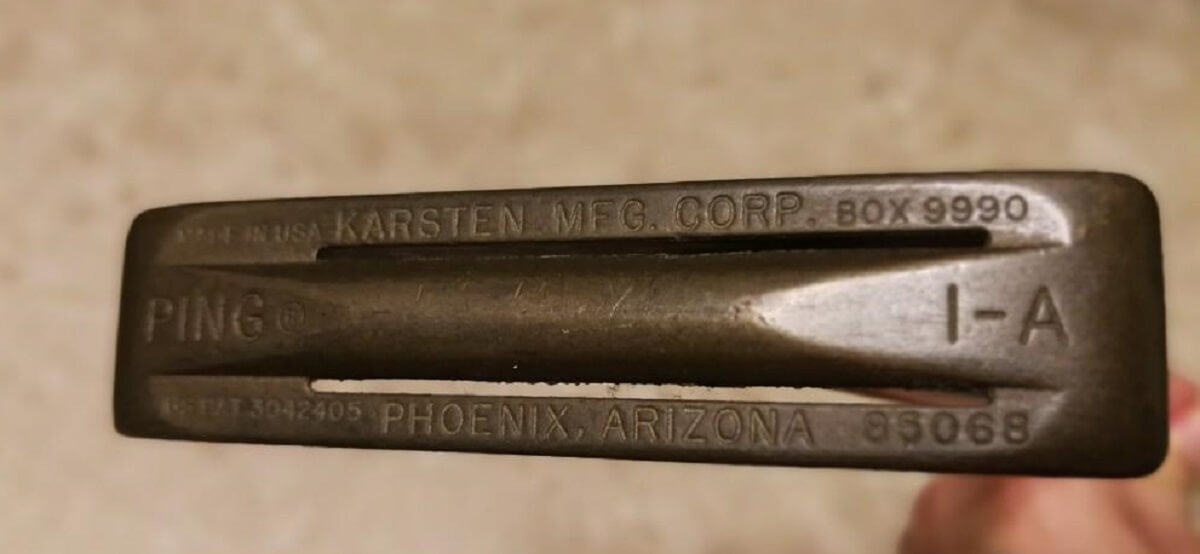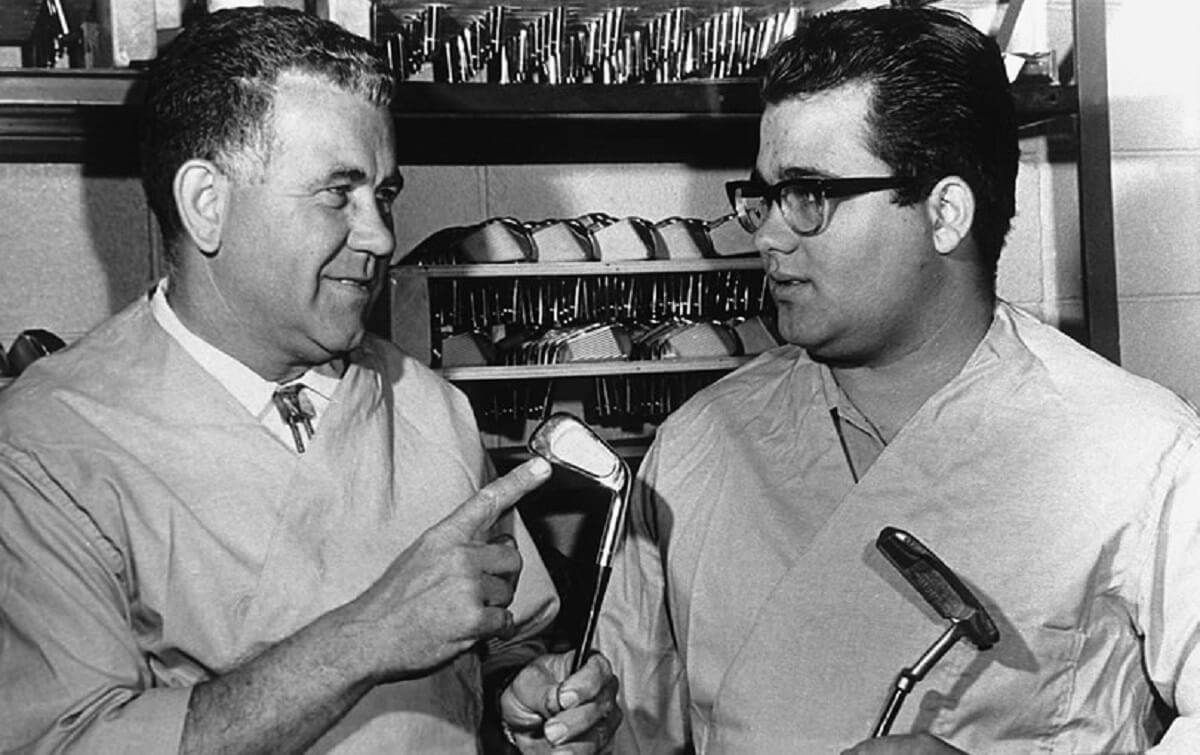Let’s fire up the Wayback Machine, fellow GolfSpies. It’s time for another edition of History’s Mysteries—MyGolfSpy’s look at the patchwork quilt that is our game’s past.
In golf history, there are three, maybe four, iconic putters. For the real historian, there’s Calamity Jane, the hickory-shafted wand Bobby Jones used to rule the 1920s. Then there’s the Wilson 8802 and Jack’s legendary MacGregor ZT-Response.
But I’m willing to bet all of Warren Buffett’s money and a sizable portion of my own that nearly everyone reading this article has played this club, or one just like it, at some point in their golfing career.
I’m talking, of course, about the PING Anser.
History’s Mysteries: The PING Anser
If Karsten Solheim isn’t on your Mount Rushmore of The Most Influential People in Golf History, then I suggest you reevaluate your list. To paraphrase Connor T. Lewis of The Society of Golf Historians, if you’re playing a modern golf club, even if it doesn’t say PING on it, you’re playing some PING technology.
“I heard Karsten talk about it so many times,” says PING Company Historian Rob Griffin. “He just wanted people to be able to enjoy the game of golf. And if he could make it a little easier for people to play better, that was really what he was about.”
PING is celebrating the 55th anniversary of the Anser patent this week. But to truly appreciate the story of the Anser, it’s important to understand Karsten Solheim’s most unusual journey.
It’s not what you’d expect.
Shoes, Skates and Cookware
Karsten Solheim was born in Bergen, Norway, in 1911. Two years later, his family moved to Seattle. His mother died giving birth to his brother Ray. Karsten and Ray were raised by family friends while their father Herman worked to support the family. With all the turmoil, Karsten didn’t learn to speak English until he was almost seven.
In his teens, he worked with his father in the family shoemaking and repair business. After graduating high school in 1931, he enrolled at the University of Washington to study engineering.
Fate had other plans.
“During his first semester, his dad had an injury and couldn’t do the work in the shoe shop,” says Griffin. “So Karsten came back to help. Working in the shoe shop taught Karsten how to work with his hands.”
Just before Christmas in 1935, fate intervened again, this time happily. At a church social, young Karsten met Louise Crozier. He proposed 10 days later and they were married the following June.
“I believe that if Karsten had married a different young lady, we would not be here today,” says Griffin. “Louise was so important to the business and to Karsten. She had a way of keeping him focused and she was his closest business advisor.”
Five years and three kids later, fate would intervene yet again. In early 1940, Karsten broke his wrist while ice skating. He couldn’t repair shoes but still had a family to feed.
He was offered a job at a car dealership but it was a demonstration of Miracle Maid aluminum cookware that caught his eye.
Yep, the man who designed the Anser and the Eye2 sold pots and pans door to door.
Miracle Maid and World War II
Miracle Maid hired Karsten as its Seattle sales rep. By his second year, he was the top salesman on the West Coast, ultimately becoming West Coast division manager and moving to Fresno, Calif.
When World War II halted Miracle Maid production, Karsten was out of a job. The military, however, needed engineers. Karsten, with one semester of college under his belt, signed up for a 10-week crash engineering extension course at the University of California in Fresno. As it turned out, Karsten was so good his professor passed him after six weeks and he was placed in an engineering job at Convair working on airplanes.
Karsten was drafted in 1943. To make sure he would have a job after the war, he applied to Ryan Aeronautical. Ryan hired him on the spot to work on the FR-1 Fireball, the Navy’s first jet-propelled fighter. Karsten helped develop the Fireball’s hydraulic landing gear.
After the war, Miracle Maid came calling with enough cash to lure Karsten back. He became the quintessential traveling salesman, often on the road all week.
“Louise helped him with the business part of it,” says Griffin. “He would go do these in-house demonstrations and he would actually cook meals with the pots and pans. That’s where he learned to be a salesman.”
In 1951, Karsten returned to Convair. He worked on the Atlas Missile project and later on a missile tracking system. In 1953, he was on the move again, going to work for General Electric in its Advanced Electronics Center in Ithaca, N.Y.
Up until this time, the 42-year-old Karsten had never even looked at a golf club.
A Pivotal Round of Golf
While in Ithaca, Karsten worked on GE’s first portable television. He designed the metal cabinet and is often—erroneously—credited with inventing the “rabbit ears” antenna.
“He didn’t invent the rabbit ears,” says Griffin. “But Karsten designed rabbit ears with a ball-type socket so they could be moved in any direction so you could tune in stations better.”
Unfortunately, GE decided not to sell the TV with the antenna due to an obscure luxury tax. So Karsten gave his patent to a Chicago company called Radion.
“You’d buy your TV from GE,” Griffin says. “But if you wanted an antenna, you’d buy it from Radion. After they sold two million sets of rabbit ears, they gave Karsten a gold-plated set.”
While no one is quite sure, Griffin believes those gold-plated rabbit ears inspired the PING Gold Putter Vault.
It was during this time that Karsten, coaxed by some co-workers, first tried golf. And like many first-timers, he was brutal. Especially at putting. He noticed that even a slight mishit would cause his blade-style putter to twist. The engineer in him went to work on a solution. He found a small block of aluminum in the GE motor shop and set about fashioning his own putter.
Karsten tried to solve the twisting problem by drilling holes at either end of the putter and filling them with lead. His crude, perimeter-weighted putter did the trick and his putting got better.
The Next Level
“Karsten never thought about building putters to sell,” says Griffin. “He was just trying to improve his own putting.”
Fate, once again, had its own plan.
By 1958, GE transferred Karsten to the Bay Area in California to work on a new computerized banking system. It was there, while on the putting green at Palo Alto Municipal GC, that head professional Pat Mahoney complimented Karsten’s skill with the flat stick.
“You should have seen me before I made this putter,” Karsten is reported to have told him.
After some discussion, Mahoney said if someone could invent a putter like his that would also get the ball rolling sooner, instead of skidding, “he could sell a million of them.”
At that moment, the figurative light bulb turned on above Karsten’s head.
Within a day, Karsten sketched what would become the prototype of the very first PING putter, the 1A, and had a friend weld it up.
“With Karsten’s first putter, he didn’t think about low center of gravity,” says Griffin. “He just thought about heel-toe weighting to prevent twisting. It was Mahoney that got him thinking about rolling the ball instead of skidding. When he made his drawing, he had what he called the Torsion Bar on the sole to get the weight lower on the putter.”
And PING? That came from the sound the putter made when it hit the ball.
The 1960s – A New Frontier
With the 1A putter and the name PING, Karsten started making putters in his garage. He was still working full time for GE, while PING consisted of Karsten designing and milling prototypes, son John as the assembly team and Louise looking after the books, answering the phone, taking orders, handling the shipping and managing inventory.
“Over the course of their lives, Karsten and Louise acquired the perfect skill set to start this putter business,” Griffin explains. “Louise always worked. She was a math whiz and worked for Convair in their wind tunnel. Her job title was ‘computer.’”
By 1960, Karsten was a fixture at PGA TOUR events, showing his putters to pros and charging them $5 each to buy one. He figured if they had to pay for putters, pros were much more likely to value them. In 1961, Karsten started experimenting with irons. The owner of Golfcraft gave him a batch of unfinished forged heads. Karsten machined out cavities and ultimately created the PING 69 Ballnamic irons which featured a signature double bend in the shaft right below the grip.
GE reassigned Karsten, now in his early 50s, once again, but the putter business continued to grow. In 1962, John Barnum gave PING its first PGA TOUR victory by winning the Cajun Classic in Louisiana. And in 1965, Susie Maxwell gave PING its first LPGA win.
But in 1966, the PING world was about to break wide open.
Three Days in January
The first PGA TOUR event of 1966 was the Las Angeles Open, Jan. 6-9. As usual, Karsten was there with his array of putters. He found few takers. Everyone, it seemed, was using Arnold Palmer’s putter—the Wilson 8802. Once he got back home, he told Louise, “I’ve got to find an answer for Arnie’s putter.”
That very night, he started sketching on the first thing he could find: the inner sleeve of an old 78-rpm vinyl record cover.
“On Jan. 14, he made a more detailed drawing on a piece of graph paper,” says Griffin. “And on that drawing, he references a sample made on Jan. 13.”
Such was the mind of Karsten Solheim. In a matter of three days, he sketched, designed and prototyped the most popular putter in the history of golf.
Three days.
That prototype sits in Griffin’s office and is shown here next to its direct descendant, the 55th-anniversary model released earlier this week.
And the Anser name? That’s all Louise.
While the design came easily, Karsten couldn’t figure out what to call his new putter. It was Louise who famously said, “Why don’t you call it the Answer?” After all, it was PING’s answer to the 8802.
Karsten’s reply is equally famous: “That’s no name for a putter.”
“They hemmed and hawed for a few days,” says Griffin. “And John Solheim remembers it was the morning Karsten was going to the engraver to have the nameplate for the putter made and he still hadn’t come up with a name.
“Louise said, ‘I told you, call it the Answer.’ And Karsten said, ‘That’s too many letters. It won’t fit.’
“And she said, ‘Well, take off the W. It’ll sound the same.’”
The PING Anser Takes Off
Karsten arrived at the Phoenix Open three weeks later with an armful of Ansers. Gene Littler, Kermit Zarley, George Archer and others gamed them almost immediately. One week later, Lionel Hebert and his Anser won the Florida Citrus Open. And two weeks after that, Harold Henning won the Texas Invitational with an Anser.
Along with Karsten’s signature heel-toe weighting, the Anser featured a hollowed-out cavity to help lower the center of gravity. It also introduced something we all take for granted today: the plumber’s-neck hosel.
At the time, PING was known for its bent Ballnamic shafts. They helped golfers to keep their hands ahead of the ball at impact. The plumber’s neck wound up doing the same thing but with a straight shaft. In addition, the Anser’s straight lines and right angles helped golfers square it up easily. It was balanced, stable and more forgiving than any other putter going.
Karsten applied for a patent on March 21, 1966. Exactly one year later, the U.S. Patent Office granted the PING Anser design patent number 207,227.
The timing couldn’t have been better. At about the same time, the USGA had decided to ban croquet-style putting, where golfers straddled the line and used a croquet stroke. Unrelated was an add-on ruling banning any shaft bends more than five inches above the sole of the club.
Since nearly all of PING’s putters and all of PING’s irons feature the Ballnamic shaft, Karsten had nothing to sell. Other than the PING Anser.
“The rule was supposed to take effect in 1968 but the Tour adopted it right away,” says Griffin. “The only putter Karsten had that complied with the rules was the Anser. It saved the business.”
It wouldn’t be the last time PING and the USGA would butt heads.
PING Becomes PING
Throughout 1966, PING was still run out of the Solheim family garage with Karsten doing the design and sales and son John handling assembly. And Karsten was still working full-time for GE. But by early 1967, GE wanted to transfer Karsten to Oklahoma City. The Solheims had moved an estimated 20 times over their 25 years together and enough was enough.
Besides, Louise had been keeping the books. She showed Karsten he was making more money selling putters than he was with GE. It was time.
So, at the age of 55, Karsten Solheim quit his job at GE, bought some land and a building and formally created Karsten Manufacturing and PING. Within two years, sales would grow from $50,000 a year to more than $800,000. The sprawling PING campus today sits at the very same location at 10834 North 21st Avenue in Phoenix.
At the time of his death in 2000, Forbes Magazine listed Karsten as one of the 400 richest people in America.
And it’s obvious to anyone who plays the game that the PING Anser is the most copied putter design in history.
“The thing about the PING Anser is that it was a design patent, not a utility patent,” says Griffin. “And design patents expire quickly. It was in effect for only about 14 years.”
Additionally, Griffin admits PING didn’t defend the patent all that vigorously.
“I don’t know exactly why but Karsten didn’t protect the patent particularly well,” he says. “We also didn’t renew it, although we could have. I think Karsten was more concerned about people using his name or the PING name.”
The PING Anser: Mystery Solved
Towards the end of our conversation, I had to ask Griffin a simple question. If Karsten walked into a golf shop today and saw all those PING Anser copies, what would he think? What would he say?
“He’d probably say something like, ‘Hey, I know where that design came from,’” Griffin replied, laughing. “I think he would be flattered. That’s the thing about Karsten that we don’t talk about enough. His real goal in life was to make the game of golf easier for people so they would enjoy it more.”
We at MyGolfSpy meet with OEM R&D engineers all the time and you’ll invariably hear them talk about perimeter weighting, forgiveness and low CG. They talk about getting the ball up in the air easier and keeping mishits in play. And more often than not, they’ll remind us it’s all stuff Karsten was talking about in the ’60s and ’70s. And it was Karsten who figured out that by lowering the CG and adding perimeter weighting, you could strengthen lofts to make the ball go farther.
It’s no exaggeration to say that virtually every golfer on the planet today has benefitted from Karsten’s innovations. Even if you’re not playing PING, you’re playing a descendant of PING technology.
And it can all be traced back to an engineer who never did have an engineering degree, who thought he could make a better putter.
And that, my friends, ansers that.
































Chuck J
1 year ago
Came across an early Ping Anser at a thrift store a few years back. Of course I had to scoop it up, paid $3.00, only putter I use.